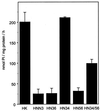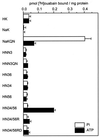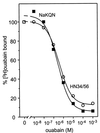High-affinity ouabain binding by a chimeric gastric H+,K+-ATPase containing transmembrane hairpins M3-M4 and M5-M6 of the alpha 1-subunit of rat Na+,K+-ATPase
- PMID: 11016952
- PMCID: PMC17179
- DOI: 10.1073/pnas.200109597
High-affinity ouabain binding by a chimeric gastric H+,K+-ATPase containing transmembrane hairpins M3-M4 and M5-M6 of the alpha 1-subunit of rat Na+,K+-ATPase
Abstract
Na(+),K(+)-ATPase and gastric H(+),K(+)-ATPase are two related enzymes that are responsible for active cation transport. Na(+), K(+)-ATPase activity is inhibited specifically by ouabain, whereas H(+),K(+)-ATPase is insensitive to this drug. Because it is not known which parts of the catalytic subunit of Na(+),K(+)-ATPase are responsible for ouabain binding, we prepared chimeras in which small parts of the alpha-subunit of H(+),K(+)-ATPase were replaced by their counterparts of the alpha(1)-subunit of rat Na(+),K(+)-ATPase. A chimeric enzyme in which transmembrane segments 5 and 6 of H(+), K(+)-ATPase were replaced by those of Na(+),K(+)-ATPase could form a phosphorylated intermediate, but hardly showed a K(+)-stimulated dephosphorylation reaction. When transmembrane segments 3 and 4 of Na(+),K(+)-ATPase were also included in this chimeric ATPase, K(+)-stimulated dephosphorylation became apparent. This suggests that there is a direct interaction between the hairpins M3-M4 and M5-M6. Remarkably, this chimeric enzyme, HN34/56, had obtained a high-affinity ouabain-binding site, whereas the rat Na(+), K(+)-ATPase, from which the hairpins originate, has a low affinity for ouabain. The low affinity of the rat Na(+),K(+)-ATPase previously had been attributed to the presence of two charged amino acids in the extracellular domain between M1 and M2. In the HN34/56 chimera, the M1/M2 loop, however, originates from H(+),K(+)-ATPase, which has two polar uncharged amino acids on this position. Placement of two charged amino acids in the M1/M2 loop of chimera HN34/56 results in a decreased ouabain affinity. This indicates that although the M1/M2 loop affects the ouabain affinity, binding occurs when the M3/M4 and M5/M6 hairpins of Na(+),K(+)-ATPase are present.
Figures








Similar articles
-
Phe783, Thr797, and Asp804 in transmembrane hairpin M5-M6 of Na+,K+-ATPase play a key role in ouabain binding.J Biol Chem. 2003 Nov 21;278(47):47240-4. doi: 10.1074/jbc.M308833200. Epub 2003 Sep 12. J Biol Chem. 2003. PMID: 12972417
-
Amino acids Val115-Ile126 of rat gastric H(+)-K(+)-ATPase confer high affinity for Sch-28080 to Na(+)-K(+)-ATPase.Am J Physiol. 1997 May;272(5 Pt 1):C1717-25. doi: 10.1152/ajpcell.1997.272.5.C1717. Am J Physiol. 1997. PMID: 9176164
-
A chimeric gastric H+,K+-ATPase inhibitable with both ouabain and SCH 28080.J Biol Chem. 1999 Mar 12;274(11):6848-54. doi: 10.1074/jbc.274.11.6848. J Biol Chem. 1999. PMID: 10066737
-
Conformational alterations resulting from mutations in cytoplasmic domains of the alpha subunit of the Na,K-ATPase.Acta Physiol Scand Suppl. 1998 Aug;643:275-81. Acta Physiol Scand Suppl. 1998. PMID: 9789570 Review.
-
[Molecular and functional diversity of NA,K-ATPase and renal H,K-ATPases].Nephrologie. 1996;17(7):401-8. Nephrologie. 1996. PMID: 9019667 Review. French.
Cited by
-
Na,K-ATPase α4, and Not Na,K-ATPase α1, is the Main Contributor to Sperm Motility, But its High Ouabain Binding Affinity Site is Not Required for Male Fertility in Mice.J Membr Biol. 2021 Dec;254(5-6):549-561. doi: 10.1007/s00232-021-00181-2. Epub 2021 Jun 15. J Membr Biol. 2021. PMID: 34129092
-
The Na+ and K+ transport system of sperm (ATP1A4) is essential for male fertility and an attractive target for male contraception†.Biol Reprod. 2020 Aug 4;103(2):343-356. doi: 10.1093/biolre/ioaa093. Biol Reprod. 2020. PMID: 32588885 Free PMC article. Review.
-
Large diameter of palytoxin-induced Na/K pump channels and modulation of palytoxin interaction by Na/K pump ligands.J Gen Physiol. 2004 Apr;123(4):357-76. doi: 10.1085/jgp.200308964. Epub 2004 Mar 15. J Gen Physiol. 2004. PMID: 15024043 Free PMC article.
-
Progesterone binding to the alpha1-subunit of the Na/K-ATPase on the cell surface: insights from computational modeling.Steroids. 2008 Jan;73(1):27-40. doi: 10.1016/j.steroids.2007.08.012. Epub 2007 Sep 2. Steroids. 2008. PMID: 17936318 Free PMC article.
-
The non-gastric H,K-ATPase as a tool to study the ouabain-binding site in Na,K-ATPase.Pflugers Arch. 2009 Jan;457(3):623-34. doi: 10.1007/s00424-008-0467-8. Epub 2008 Mar 7. Pflugers Arch. 2009. PMID: 18324411
References
Publication types
MeSH terms
Substances
LinkOut - more resources
Full Text Sources

